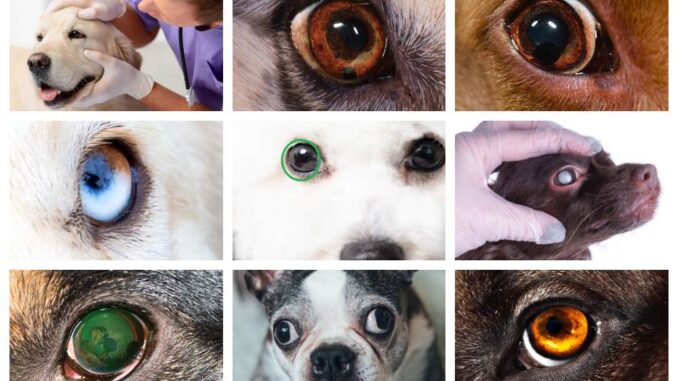
This article was updated on October 20th, 2023

A few years ago, my daughter noticed that our Springer Spaniel had tiny white dots on one eye. As a veterinarian, I was able to quickly examine our pooch and confirm that there was nothing to worry about. But white, red, black, or brown spots in a dog’s eye can also be a reason for concern. There are several conditions that can cause these spots. Some are benign, while others are not. In this article, we’ll examine what causes these spots, and when to be concerned.
If your dog has a new brown, white, or red spot on their eyes, click on one of the images below (or keep reading):
Let’s break it down:
1. Black or brown spots
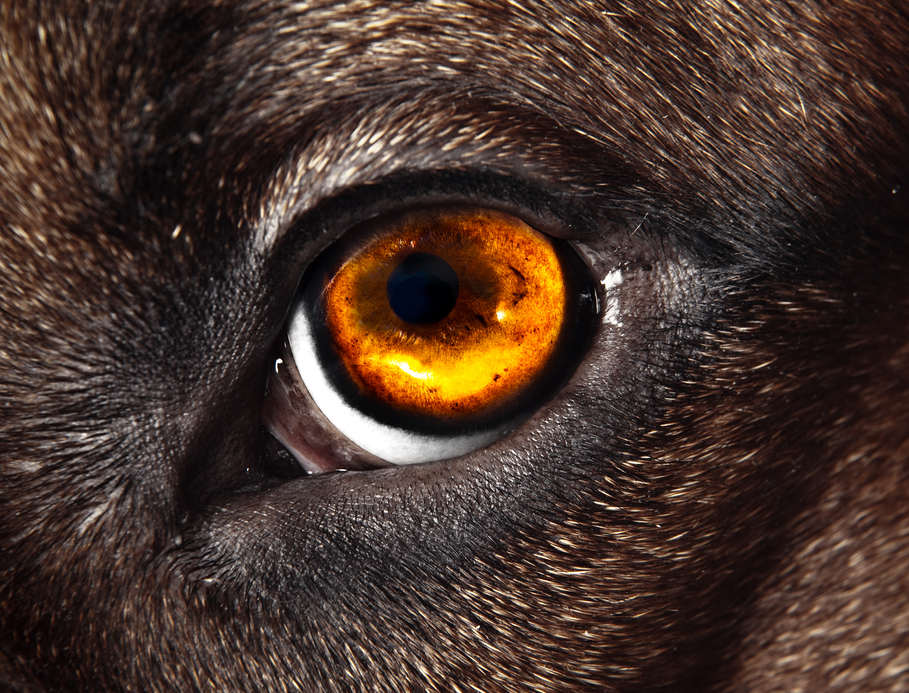
Black or brown spots on the eye may be harmless, but they can also be a sign of cancer or other diseases that can cause blindness. Symptoms for these conditions are fairly similar, so veterinary diagnosis is necessary. Learn more: Black or Brown Spots in My Dog’s Eyes.
2. White spots/cloudy spots

Like dark spots, white or gray-colored areas on the eye are not normal. They may be harmless or serious and lead to blindness over time. The size and character of white or gray spots on your dog’s eye can help you or your veterinarian determine the underlying cause. Common conditions include:
- Nuclear sclerosis: Age-related bluish-gray haziness of the lens, often confused with cataracts but doesn’t significantly impair vision.
- Corneal ulcer: Open sore on the cornea, often painful, resulting from trauma or infection.
- Uveitis: Painful inflammation of the eye’s middle layer, causing redness and potential cloudiness.
- Other conditions include cholesterol deposits on the cornea or corneal endothelial degeneration.
Learn more About White Spots in Dog Eyes or Cloudy Eyes in Dogs.
3. Red spots
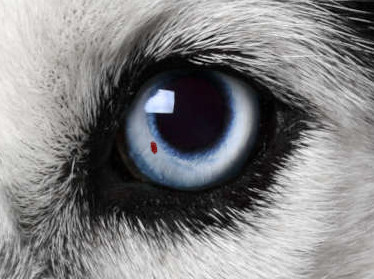
When a dog has pink-red spots, it is usually due to inflammation or hemorrhage (This inflammation could be caused by a ruptured capillary, allergic reaction, or injury).
Pooling caused by ruptured capillaries usually resolves in a week or so without treatment. Your veterinarian will prescribe topical antibiotics and anti-inflammatory eye drops to treat inflammation. They may also recommend using an eye wash to flush irritants from the eye gently.
Learn more about Small Red Spots in a Dog’s Eyes.
8 pictures showing common conditions causing spots on dogs’ eyes
1. Cataracts
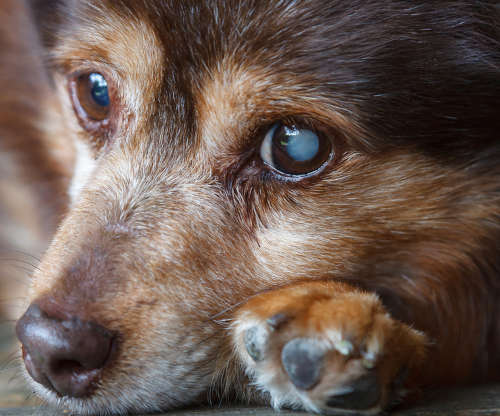
Cataracts in dogs can be hereditary or caused by a disease like diabetes. Either way, the lens of one or both eyes becomes cloudy-white. If only 30% of one eye is affected, your dog will probably have normal vision. When dogs develop cataracts, you may notice your dog has:
- A white spot in the middle of the eye that may be pinpointed or grow to cover the entire eye
- Disorientation and confusion
- Poor depth perception
- Trouble bumping into things
- A tendency to become easily frightened
There is currently no medical treatment to delay cataracts in dogs, and it’s usually a progressive condition. The only option to restore your dog’s vision is the surgical removal of the lens by a veterinary ophthalmologist. In this case, dogs usually return to normal activity in a few days.
Learn more about Cataracts.
2. Corneal ulcers

A corneal ulcer is an erosion of the cornea that may be caused by trauma, dryness, infection, or other circumstances. When an ulcer forms, all or part of the cornea becomes cloudy due to fluid buildup from inflammation. Dogs with corneal ulcers may have:
- Redness around the eye
- Pain
- Excessive tearing
- Photosensitivity
- Pawing at the face
- Keeping the eye shut
Treatment for a mild ulcer usually involves the application of a broad-spectrum ophthalmic ointment and topical painkillers. If the ulcer is deep or complications arise, surgery may be necessary. The prognosis for simple corneal ulcers is generally excellent. More complicated cases may require protracted or life-long treatment.
Learn more about Corneal Ulcers (With Pictures).
3. Eye infections
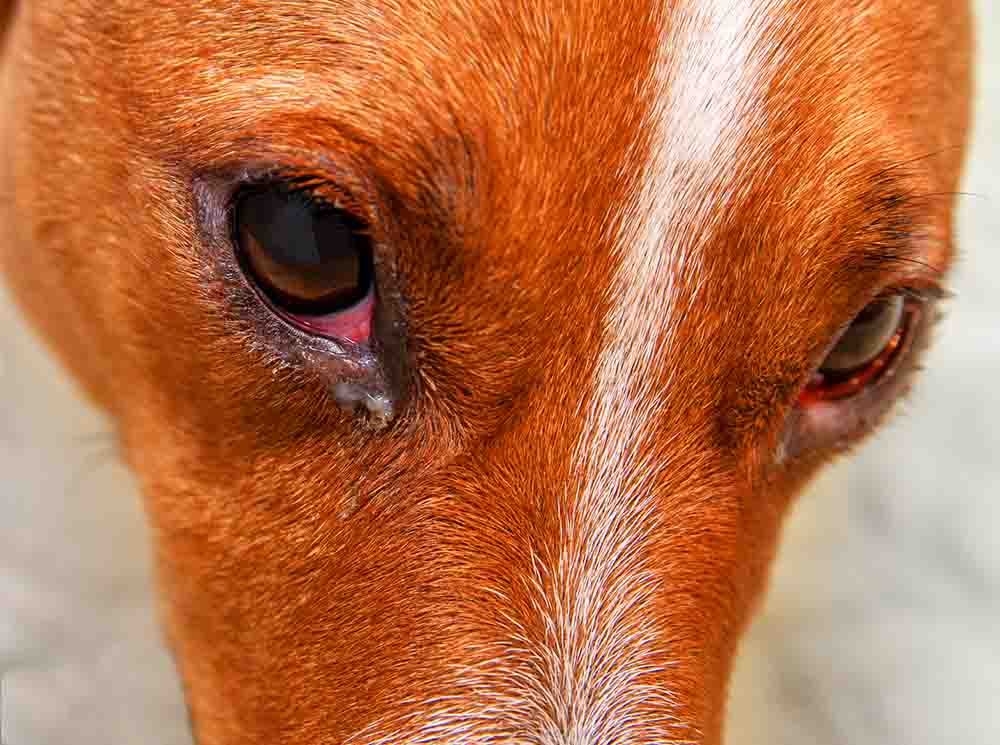
Dogs with eye infections or conjunctivitis may develop cloudy spots or redness in the eye due to inflammation. Other symptoms include:
- Drainage from the eye – yellow, green, or red
- Swelling or crusting with hair loss
- Red, swollen membranes around the eye
- Redness of the white of the eye
- Squinting or holding the eyes shut
- Rubbing
Treatment for these infections is usually a topical antibiotic solution in the form of eye drops. For conjunctivitis, the antibiotics may be oral. The prognosis with treatment is excellent.
Learn more Eye Infections (with Pictures & Vet Advice).
4. Nuclear sclerosis
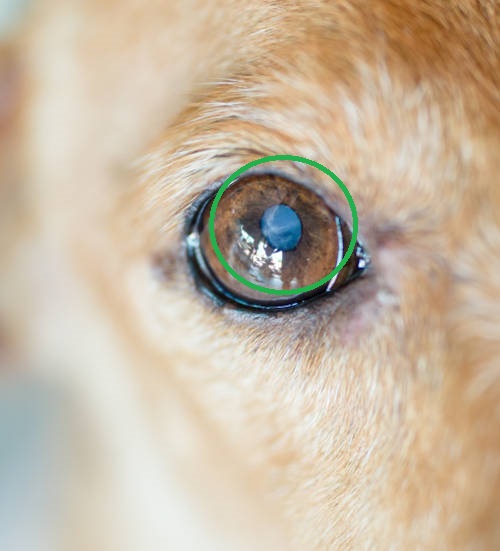
As dogs age, they may experience nuclear sclerosis. When this happens, the lens nucleus becomes opaque. Signs of the condition include:
- Cloudy or hazy eyes
- A bluish or gray tint in the center of the eye
- May affect one or both eyes
There is no treatment needed for nuclear sclerosis. Dogs generally don’t experience loss of vision from this condition, and it is considered a normal part of aging.
Learn more about Nuclear Sclerosis.
5. Eye Cyst
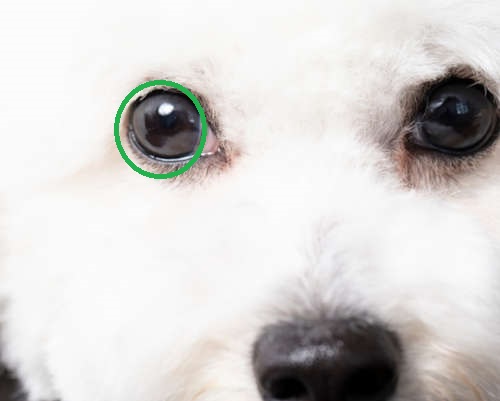
Eye cysts may occur in the iris, choroid, or choroid areas. Appearing as black, fluid-filled discs, the cysts are usually a few millimeters in diameter. Sometimes, the spots float around in the eye, but others appear fixed. While generally painless, eye cysts can affect your dog’s vision.
As long as eye cysts aren’t causing your dog any problems, they don’t require treatment. If, however, they grow larger and begin to obstruct your pup’s vision, they will require surgical treatment, which may be by aspiration or laser ablation.
View more pictures of eye cysts with vet advice.
6. Cholesterol deposits on the cornea
Round or oval-shaped white to grayish-white spots in your dog’s eye may be due to deposits of cholesterol in the cornea (view pictures). These deposits may be due to an inherited condition, elevated blood cholesterol levels, or corneal degeneration (common in senior dogs). Symptoms include:
- Usually, only one eye is affected
- Sparkly, crystalline, or shiny material in the eye
- It may include eye redness or cloudiness
The treatment for corneal lipidosis depends on the cause. Learn more on VCA Hospitals. The prognosis depends on the underlying cause but is generally favorable with the appropriate treatment.
7. Uveitis
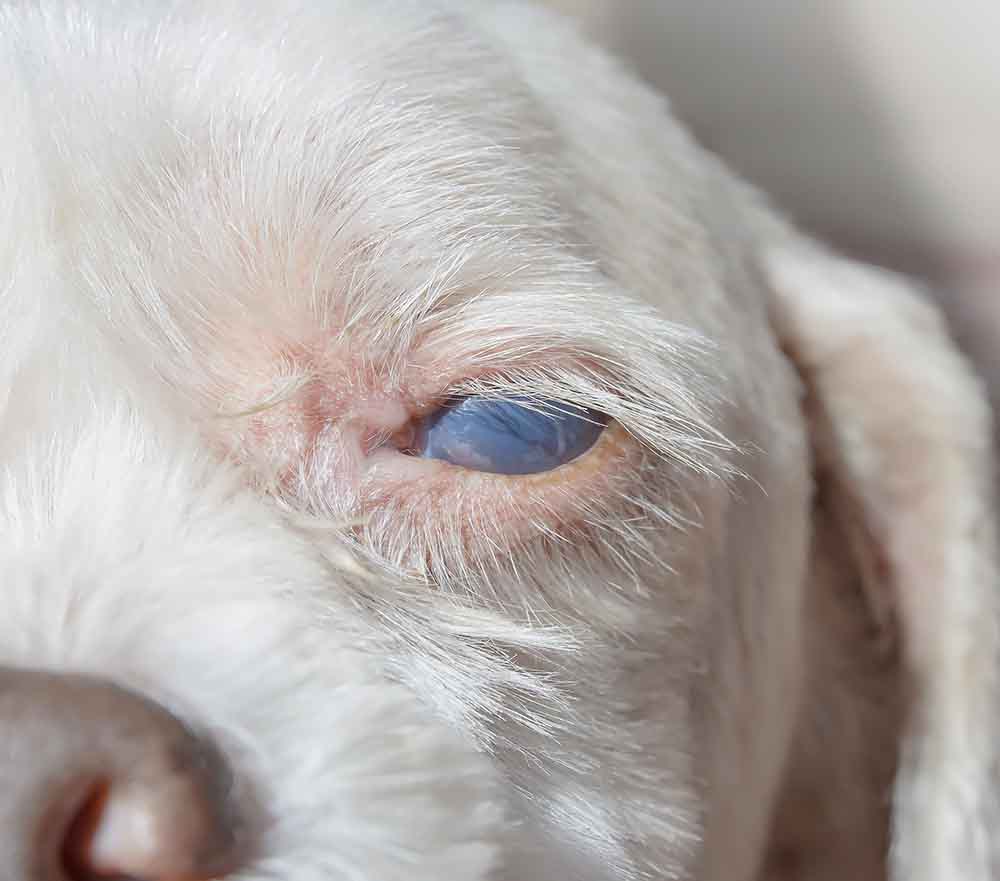
Inflammation of one or more parts of the uvea can cause a red or cloudy appearance in the center of the eye. Depending on how much of the uvea is involved, there may be brown spots, one cloudy spot, or a larger disc. Symptoms include:
- Red eye
- Squinting
- Pain
- Photosensitivity
- Excessive tearing
- Cloudy or bluish cornea
- Blood or pus
Treatment can vary depending on the cause and may include:
- Topical steroids
- Non-steroidal anti-inflammatory eye drops
- Repair of corneal tears
- Removal of foreign bodies
The prognosis for uveitis is usually favorable with early treatment. If the condition is severe or recurrent, it may cause blindness.
8. Pigmentary keratitis
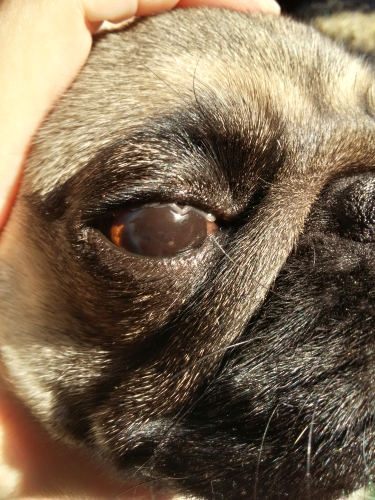
Brownish-black discoloration of the eye’s surface, or pigmentary keratitis, is due to deposits of melanin granules. It’s triggered by chronic inflammation. Signs include:
- Visible pigment in the cornea – ranges from brown speckles to black patches
- Reddened conjunctival membranes
- Eye discharge
- Bloodshot white of the eye
Treatment involves addressing the underlying condition that causes the condition. It may include antibiotics, corticosteroids, artificial tears, or surgery.
The melanin deposits in the eyes are rarely reversible.
9. Melanoma of the eye
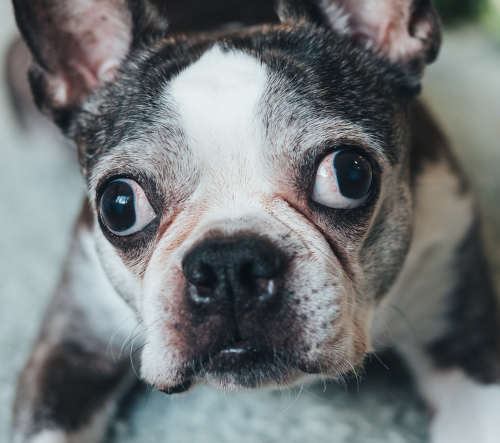
Sometimes, melanocytes in the uvea or limbus grow uncontrollably and affect the appearance of the eye. These masses may be benign or malignant. Signs may include:
- Circular brown or black spots on the iris that may be raised or flat
- Dark mass inside the eye that protrudes through the pupil
- Intraocular bleeding
- Rubbing the eye
- Redness
- Tearing
Even if benign, the mass may continue to grow without treatment. Eventually, it may invade the cornea, cause the eye to rupture, or cause other problems. Treatment for melanoma varies but may involve:
- Partial removal of the iris
- Laser surgery
- Enucleation
Overall, the prognosis is good, but tumors regrow in about 30% of dogs.
Learn more about Melanomas.
Many of these conditions share common symptoms, so it can be difficult to discern harmless conditions from serious health threats.
If you notice new spots or cloudiness in your dog’s eye(s), you should contact your veterinarian. It is particularly important to bring your dog to the vet if you notice symptoms like:
- Bumping into things in the house
- Inflamed, irritated eyes
- Anxiety or hesitation in unfamiliar surroundings
- Easily startled
- Rubbing
- Squinting or sensitivity to light
- Bulging eyes
When are these eye spots likely NOT a cause for concern?
Dogs that don’t have the symptoms listed above and appear to have normal vision may not need immediate veterinary care. Monitor your pooch closely until their next scheduled appointment. If you notice sudden changes, call the doctor to discuss your observations.
Can new spots on my dog’s eyes be a sign of cancer?
yes, some tumors of the eye can present as spots on or inside the globe. For example, melanoma of the eye may appear as a black or dark brown spot. Multicentric lymphoma can also infiltrate the uvea, causing a white or pink spot inside the eye. In case of any doubt, be sure to check with your veterinarian.
Learn more:
Disclaimer: This website's content is not a substitute for veterinary care. Always consult with your veterinarian for healthcare decisions. Read More.



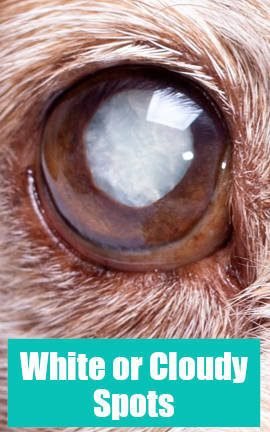
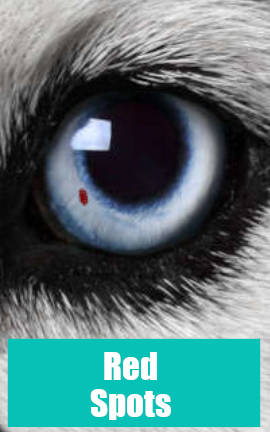
Be the first to comment